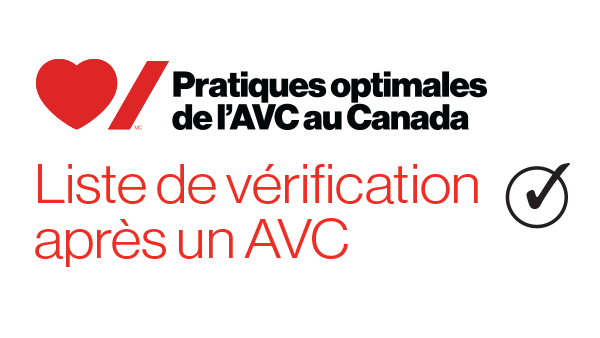- Définition et considérations
- 1. Évaluation initiale des besoins en matière de réadaptation post-AVC
- 2. Soins offerts dans les unités de réadaptation post-AVC
- 3. Prestation des soins de réadaptation post-AVC en milieu hospitalier
- 4. Réadaptation à domicile et en consultation externe post-AVC (y compris le congé précoce assisté)
- 5.1 Prise en charge des membres supérieurs après un AVC : principes généraux et traitements
- 5.2 Amplitude du mouvement et spasticité de l’épaule, du bras et de la main
- 5.3 Prise en charge de la douleur à l’épaule et du syndrome douloureux régional complexe (SDRC) après un AVC
- 6.1 Équilibre et mobilité
- 6.2 Spasticité des membres inférieurs après un AVC
- 6.3 Prévention et prise en charge des chutes
- 7. Évaluation et prise en charge de la dysphagie et de la malnutrition après un AVC
- 8. Réadaptation en cas de troubles de la perception visuelle
- 9. Prise en charge de la douleur centralisée
- 10. Réadaptation en vue d’améliorer la capacité à parler et à communiquer
- 11. Téléréadaptation après un AVC
Recommandations
Définition : Aux fins de l’interprétation des présentes recommandations, « précoce » désigne le niveau de preuve pour les traitements qui s’appliquent aux patients dont l’AVC date de moins de six mois et « tardif » désigne le niveau de preuve pour les traitements qui s’appliquent aux patients dont l’AVC de référence date de plus de six mois.
A. Considérations générales
- Les patients devraient participer à un entraînement significatif, mobilisateur, progressif, intensif, axé sur les tâches et les objectifs dans une tentative d’amélioration de la mobilité et de l’aptitude à effectuer des transferts [niveau de preuve : précoce – A; tardif – A].
B. Entraînement à la marche
- Les exercices de renforcement devraient être envisagés chez les personnes dont le niveau de fonction motrice des membres inférieurs est faible à modéré aussi bien pendant la phase subaiguë [niveau de preuve C] que lors de la phase chronique [niveau de preuve B] du rétablissement. Les exercices de renforcement n’affectent pas la tonicité et n’aggravent pas la douleur [niveau de preuve A].
- Un entraînement répétitif et progressivement adapté, qui est axé sur les tâches et les objectifs, est recommandé pour améliorer la distance et la vitesse de marche ainsi que l’exécution de certaines tâches impliquant les membres inférieurs, comme de se lever à partir d’une position assise [niveau de preuve : précoce – A; tardif – A].
- L’entraînement à la marche sur tapis roulant (avec ou sans soutien du poids corporel) devrait servir à améliorer la distance et la vitesse de marche comme traitement complémentaire de l’entraînement sur le sol ou lorsque ce dernier n’est pas possible ou approprié [niveau de preuve : précoce – A; tardif – A].
- Des dispositifs d’assistance électromécaniques (robotiques) d’entraînement à la marche sont envisageables pour les patients qui, autrement, ne pratiqueraient pas la marche. Ils ne se substituent pas à un traitement traditionnel de marche [niveau de preuve : précoce – A; tardif – A].
- L’utilisation de la stimulation auditive rythmique (SAR) est envisageable pour améliorer les paramètres liés à la marche chez les patients ayant survécu à un AVC, notamment la vitesse, la cadence et la symétrie de la marche ainsi que la longueur de la foulée [niveau de preuve A].
- L’entraînement par la réalité virtuelle (notamment les technologies non immersives) pourrait servir de traitement complémentaire à l’entraînement à la marche traditionnel [niveau de preuve B].
- La pratique mentale pourrait être utilisée comme traitement complémentaire à l’entraînement visant le rétablissement des fonctions motrices des membres inférieurs [niveau de preuve A].
- Chez certains patients, il faudrait envisager l’utilisation de la stimulation électrique fonctionnelle (SEF) dans le cadre de la thérapie visant à améliorer la force et les fonctions motrices pour la marche, mais les effets pourraient ne pas être maintenus [niveau de preuve : précoce – A; tardif – A].
- La rétroaction biologique, sous la forme de signaux visuels et auditifs pour indiquer un décalage et une répartition inégale du poids, peut favoriser l’entraînement à la marche et le rétablissement fonctionnel [niveau de preuve B].
- Le besoin en matière d’appareils spécialisés, comme les dispositifs d’aide à la marche et les fauteuils roulants, devrait être évalué au cas par cas [niveau de preuve : précoce – C; tardif – C].
- L’ordonnance et l’acquisition relatives aux appareils spécialisés devraient être fondées sur l’anticipation d’un besoin à long terme [niveau de preuve : précoce – C; tardif – C].
- Après l’obtention d’un appareil spécialisé, il faudrait évaluer périodiquement, le cas échéant, si le patient en a encore besoin ou s’il peut cesser de l’utiliser [niveau de preuve : précoce – C; tardif – C].
- L’orthèse pédi-jambière pourrait aider certains patients chez qui un pied tombant a été diagnostiqué. Un suivi doit déterminer l’efficacité du traitement pour le patient [niveau de preuve : précoce – A; tardif – A].
C. Équilibre
- Les thérapeutes doivent prendre en considération le contrôle de l’équilibre tant volontaire que réactif dans le cadre de l’évaluation et du traitement [niveau de preuve C].
- Pour améliorer l’équilibre après un AVC, les traitements suivants sont envisageables:
- L’entraînement musculaire du tronc ou l’entraînement pour le rétablissement de l’équilibre en position assise [niveau de preuve : précoce – A; tardif – A].
- L’entraînement debout (comme de se lever à partir d’une position assise) [niveau de preuve : précoce –A].
- La rétroaction biologique sur plateforme de force [niveau de preuve : précoce –A; tardif – A] et la formation axée sur les tâches avec ou sans intervention multisensorielle [niveau de preuve : tardif – A].
- L’entraînement sur tapis roulant avec appareil de suspension partielle du poids corporel [niveau de preuve : précoce – B].
- L’entraînement pour le rétablissement de l’équilibre combiné à la réalité virtuelle dans la phase tardive de l’AVC [niveau de preuve A], mais pas dans sa phase précoce [niveau de preuve A].
- L’utilisation de surfaces instables et de balanciers [niveau de preuve : tardif – A].
- Le cyclisme [niveau de preuve : précoce – B; tardif – B].
- L’entraînement pour le rétablissement de l’équilibre en milieu aquatique [niveau de preuve : tardif – B]
- Le tai-chi [niveau de preuve B].
- L’entraînement pour le rétablissement de l’équilibre combiné à la rétroaction visuelle, à l’imagerie motrice et à la vibrotonie corporelle n’améliore pas l’évolution de l’équilibre [niveau de preuve : précoce –A].
D. Entraînement aérobique
- Les patients dont l’état de santé est stable devraient se soumettre à un examen de la capacité de participer à des exercices aérobiques par des professionnels de la santé dûment qualifiés et spécialisés en entraînement aérobique [niveau de preuve C].
- Les antécédents médicaux et l’examen physique devraient être effectués pour déterminer les facteurs qui nécessitent une attention particulière ou qui constituent une contre-indication à l’exercice aérobique [niveau de preuve : précoce – B; tardif – B].
- Une épreuve d’effort avec électrocardiogramme et la surveillance de la pression artérielle et des symptômes subjectifs devraient être envisagées, en particulier pour les patients ayant des antécédents connus de maladie cardiovasculaire [niveau de preuve : précoce – C; tardif – C].
- Si le programme prévu doit être d’intensité légère (soit < 40 à 45 % de la valeur prédite de la réserve de fréquence cardiaque), une épreuve clinique sous maximale (p. ex., l’épreuve des six minutes de marche) pourrait convenir pour évaluer l’aptitude du patient à participer à un programme d’exercices aérobiques [niveau de preuve : précoce – C; tardif – C].
- Les exercices aérobiques personnalisés qui font travailler les grands groupes musculaires devraient être intégrés dans un programme complet de réadaptation post-AVC visant à améliorer l’endurance cardiovasculaire et la fonction cognitive [niveau de preuve : précoce – A; tardif – A].
- Pour obtenir des résultats, les patients doivent s’exercer au moins trois fois par semaine pendant un minimum de huit semaines, progressant à des périodes de 20 minutes ou plus (sans compter les périodes d’échauffement et de récupération) par séances, selon le niveau de tolérance [niveau de preuve : précoce – B; tardif – B].
- La fréquence cardiaque et la pression artérielle devraient être surveillées pendant l’entraînement pour assurer la sécurité du patient et l’atteinte de l’intensité cible de l’exercice [niveau de preuve : précoce – A; tardif – A].
- Afin d’assurer le maintien à long terme des bienfaits de l’entraînement sur la santé, il est recommandé de planifier la transition des exercices aérobiques structurés vers un entraînement plus autonome à domicile ou dans la collectivité [niveau de preuve : précoce – A; tardif – A].
- Des stratégies devraient être employées pour surmonter des obstacles particuliers à l’activité physique en lien avec le patient, les fournisseurs de soins de santé, la famille et l’environnement [niveau de preuve : précoce – A; tardif – A].
L’AVC affecte souvent l’équilibre et l’usage des jambes. La capacité de marcher est précieuse aux yeux des patients et facilite leurs interactions quotidiennes. En plus de l’objectif d’amélioration des capacités de marche et de la sécurité de cette activité, les aptitudes de base à se mettre debout et à effectuer des transferts de façon sécuritaire doivent être acquises. Pour se déplacer en toute sécurité, les patients peuvent avoir besoin d’un appareil fonctionnel comme une canne ou une marchette. Un niveau raisonnable d’endurance, d’équilibre et de vitesse de marche est essentiel pour qu’un tel appareil remplace l’utilisation d’un fauteuil roulant. Malheureusement, certaines personnes ne récupéreront pas leur capacité de marcher de façon autonome et auront besoin d’un fauteuil roulant.
Les personnes ayant subi un AVC ont souligné l’importance de la participation des membres de leur famille et de leurs aidants lorsqu’ils reçoivent de l’instruction et de la formation sur la marche, la mobilité et les exercices aérobiques.
Pour évaluer et prendre en charge de façon appropriée et en temps opportun la mobilité de base, le contrôle postural, les fonctions motrices des membres inférieurs, la marche et l’aptitude aux transferts, l’organisme ou l’établissement de réadaptation doit fournir les éléments suivants:
- La disponibilité de soins de réadaptation post-AVC organisés, notamment des unités de réadaptation post-AVC dotées d’une équipe interdisciplinaire ayant reçu la formation appropriée et comptant le personnel nécessaire.
- Une évaluation initiale et continue uniformisée, effectuée par des cliniciens ayant la formation et l’expérience appropriées en matière de réadaptation post-AVC.
- L’accès en temps opportun à des services de réadaptation post-AVC spécialisés et interdisciplinaires, tels qu’ils sont définis dans les Recommandations.
- L’accès en temps opportun à des soins de réadaptation d’intensité appropriée aux survivants d’un AVC, notamment l’entraînement consistant à passer de la position assise à debout, tel qu’il est défini dans les Recommandations.
- L’accès aux appareils et accessoires fonctionnels nécessaires pour favoriser la sécurité et l’autonomie. Ils devraient être abordables. Des processus devraient être en place pour assurer une évaluation adéquate des patients afin de répondre à leurs besoins en matière d’équipement (p. ex., évaluation des sièges).
- L’accès aux épreuves d’effort contrôlées par électrocardiogramme et à un médecin qui a l’expérience nécessaire pour élaborer un programme d’exercices aérobiques d’une intensité appropriée.
- Amélioration de l’état fonctionnel selon le test des six minutes de marche à partir de l’admission dans un programme de réadaptation en milieu hospitalier jusqu’à la sortie. Amélioration de l’état fonctionnel (p. ex., selon les résultats de locomotion de la MIF) à partir de l’admission dans un programme de réadaptation en milieu hospitalier jusqu’à la sortie.
- Délai médian entre l’admission aux soins de courte durée d’un hôpital en raison d’un AVC et l’évaluation du potentiel de réadaptation effectuée par un spécialiste des soins de réadaptation.
- Durée médiane du séjour dans une unité de réadaptation post-AVC pendant la réadaptation active en milieu hospitalier.
- Nombre moyen d’heures par jour de thérapie axée sur les tâches (minimum de trois heures) offerte par l’équipe interdisciplinaire de soins de l’AVC.
- Nombre moyen de jours par semaine de thérapie axée sur les tâches (minimum de cinq jours) offerte par l’équipe interdisciplinaire de soins de l’AVC.
- Amélioration de l’état fonctionnel (p. ex., selon les résultats sur la sous-échelle pour les membres inférieurs de l’échelle d’évaluation d’AVC Chedoke-McMaster) à partir de l’admission dans un programme de réadaptation hospitalier jusqu’à la sortie.
- Amélioration de l’état fonctionnel selon une échelle d’évaluation uniformisée (p. ex, la MIF) à partir de l’admission dans un programme de réadaptation en milieu hospitalier jusqu’à la sortie (moyenne et médiane).
- Amélioration de l’état fonctionnel des membres inférieurs selon une échelle d’évaluation uniformisée (p. ex., l’échelle d’évaluation d’AVC Chedoke-McMaster) à partir de l’admission dans un programme de réadaptation hospitalier jusqu’à la sortie.
- Diminution de la spasticité des membres inférieurs selon une échelle d’évaluation uniformisée (p. ex., l’échelle d’Ashworth modifiée) à partir de l’admission dans un programme de réadaptation en milieu hospitalier jusqu’à la sortie.
Notes relatives à la mesure des indicateurs
- La durée de la thérapie peut être extraite des systèmes de mesure de la charge de travail des professionnels de la réadaptation, s’il y a lieu.
- Le test de vitesse de marche sur cinq ou dix mètres peut être utilisé comme outil d’évaluation de base chez les patients qui ne sont pas encore en mesure de faire le test des six minutes de marche.
- Il faut veiller à ce que les points de départ de la mesure soient uniformes pour toutes les mesures de temps.
Renseignements destinés aux fournisseurs de soins de santé
- Tableau 1 : Outils de dépistage et d’évaluation pour la réadaptation post-AVC (en anglais)
- MIF
- Logiciel AlphaFIM® (en anglais seulement)
- L’échelle d’évaluation d’AVC Chedoke-McMaster
- L’échelle d’Ashworth modifiée
- Test de six minutes de marche
- L’échelle d’évaluation Fugl-Meyer
- Catégories de marche fonctionnelle
- Timed Up and Go Test (test chronométré de levée et de marche)
- L’échelle d’équilibre de Berg
- Info AVC
Informations destinées aux personnes ayant subi un AVC, à leur famille et à leurs aidants
- Prendre en main son rétablissement : fiche d’information sur la réadaptation et le rétablissement
- Prendre en main son rétablissement : fiche d’information sur les transitions et la participation communautaire
- Aphasia Institute (en anglais seulement)
- Liste de contrôle post-AVC
- Le répertoire des services et ressources de Cœur + AVC
- Votre cheminement après un accident vasculaire cérébral : un guide à l’intention des survivants de l’AVC
- Info AVC
Lien vers les tableaux de données probantes et la liste des références (en Anglais)
Lower-Limb Gait Training
Strength Training
Many individuals experience muscle weakness as a consequence of stroke. Strength training may help to improve measures of gait and balance. Flansbjer et al. (2008, 2012) randomized 24 persons living in the community a minimum of 6 months post stroke to a training group that participated in supervised progressive resistance training of the knee muscles twice weekly for 10 weeks, or to a control group who continued their usual daily activities. The authors found that on the paretic side, the mean dynamic knee muscle strength extension and flexion in the intervention group had improved significantly more at the end of treatment and was maintained at 4-year follow-up compared to the control group. However, there were no significant differences between groups in mean improvement on the Timed-up-and Go test, gait speed or distance traveled on the 6-Minute Walk Test at 4 years. Cooke et al. (2010), randomized participants with subacute stroke (mean 1 month) to one of three treatment groups for a duration of 6 weeks: 1) conventional physiotherapy (CPT) + Functional Strength training (FST); 2) extra intensity training (CPT + CPT); or 3) CPT alone. Following the intervention both experimental groups showed improvement in walking speeds over the CPT alone group, but this reached significance in the CPT + CPT group. The CPT + CPT group also showed significant improvement in the number of participants with a walking speed over 0.8m/s compared to the CPT group. No significant differences were noted between-groups for torque about the knee, symmetry step length, symmetry step time, the Rivermead score, or on the EuroQoL. At the 12-week follow-up no significant differences were identified between groups.
Task Oriented Training (Task-Specific Training)
Task oriented training (also called task-specific training) involves active practice of task-specific motor activities. Repeated motor practice has been shown to improve walking speed and functional ambulation.
A Cochrane review by English et al. (2017) pooled findings from 17 RCTs that compared circuit class training with at least 3 clients, provided for a minimum of once-weekly sessions for a minimum of four weeks, with no therapy, sham therapy, or another therapy modality. Only studies that reported interventions with a focus on repetitive practice of functional tasks arranged in a circuit, with the aim of improving mobility, were included. Pooling the results from 10 trials, the mean distance walked during the 6-minute walk test was 60.86 metres further (95% CI 44.55 to 77.17m), compared with the control condition, which exceeded the minimal clinically important difference of 34.4 metres. The mean gait speed in the intervention groups was 0.15 metres/ second faster (0.10 to 0.19 m/s) compared with the control group. Other outcomes with scores significantly higher in the intervention group included Timed-up-and Go, Stroke Impact Scale, Functional Ambulation Classification and the Rivermead Mobility Index. In another Cochrane review, French et al. (2016) examined task-specific training on upper and lower-limb functions compared with usual care, an alternative intervention, or no care. Lower limb repetitive task-oriented training interventions were tested in 17 trials. Two trials focused on interventions specifically on sit-to-stand practice, 6 trials focused on walking practice, while 4 trials investigated interventions that focused specifically on sitting balance trunk control, and balance. Repetitive task training was associated with significantly greater improvements in walking distance (MD= 34.80 metres, 95% CI 18.19 to 51.41 metres; 9 studies) and functional ambulation (SMD= 0.35, 95% CI 0.04 to 0.66; 8 studies), sit-to-stand post treatment (SMD=0.35, 95% CI 0.13 to 0.56, 7 studies) and standing balance or reach (SMD= 0.24, 95% CI 0.07 to 0.42; 9 studies).
Treadmill Training with and without Body Weight Support
In a Cochrane review, Mehrholz et al. (2017) included the result of 56 trials (n=3,105) and concluded that patients with stroke who received treadmill training (with or without body weight support) in combination with physiotherapy had significantly improved gait velocity (mean difference=0.06 m/s, 95% CI 0.03 to 0.09) and greater walking endurance (MD=14.19 metres, 95% CI 2.92 to 25.46), when assessed at the end of treatment. Among studies evaluating treadmill training with body weight support, patients were no more likely to achieve independent walking than patients receiving gait training without these devices (risk difference= -0.00, 95% CI -0.02 to 0.02), nor was gait velocity or walking endurance increased significantly at the end of scheduled follow-up (MD=0.03 m/s, 955 CI -0.05 to 0.10 and MD= 21.64 m, 95%CI -4.70 to 47.98). In the MOBILISE trial, (Ada et al. 2010, Dean et al. 2010) 126 patients were randomized to an experimental or a control group within 28 days of stroke and received treatment until they achieved independent walking or for as long as they remained in hospital. Participants in both groups received 30 minutes of walking practice 5 days/week. Additional lower-limb therapy was provided for an additional 30 minutes/day. Participants in the experimental group undertook up to 30 minutes per day of treadmill walking with sufficient body weight support such that initially, the knee was within 15 degrees of extension in mid stance. The control group received up to 30 minutes of over-ground walking training, with the use of aids, if required. Although there were no differences in the proportion of independent ambulators between groups at one, two or 6 months, participants in the experimental group achieved independence in ambulation a median of 14 days sooner.
Electromechanical/Robot-Assisted Gait Training Devices
In an updated Cochrane review, Mehrholz et al. (2017) included 36 trials studies (n=1,472) that were examined the effectiveness of electromechanical and robot-assisted gait training for improving walking after stroke. Treatments included electromechanical and robot-assisted gait training devices (with or without electrical stimulation) which are designed to assist stepping cycles by supporting body weight and automating the walking therapy process with the addition of physiotherapy compared with physiotherapy or routine care only. Electromechanical-assisted gait training in combination with physiotherapy increased the odds of participants becoming independent in walking at the end of treatment (OR=1.94, 95% CI1.39 to 2.71; p< 0.001) and at the end of follow-up, but did not significantly increase walking velocity (MD=0.04 m/s, 95% CI 0.00 to 0.09;p =0.08) or walking capacity (MD= 5.84 metres walked in 6 minutes, 95% CI -16.73 to 28.40; p= 0.61). The odds of becoming an independent ambulator were higher for persons treated within the first three months of stroke onset (OR=1.9 vs. OR=1.2). Morone et al. (2011, 2012) included 48 participants, an average of 20 days post stroke, stratified by motor impairment (high vs. low). All patients underwent standardized rehabilitation for 3 months. After one week of therapy, participants in the robotic group underwent additional robotic-assisted gait training instead of a second therapy session (20 sessions in total) while those in the control group participated in a second therapy session. At the end of treatment participants in the low impairment robot group had improved significantly more than participants in the low impairment control group on the Functional Ambulation Category (FAC) (p<0.001), the Rivermead Mobility Index (p=0.001) and the 6-Minute Walk test (p=0.029). Although participants in the high impairment groups also improved over time, there were no significant between-group differences on any of the outcomes. At 2-year follow-up, patients in the low impairment robot group continued to demonstrate significantly improved scores, while there were no significant differences between groups for highly-impairment patients.
Rhythmic Auditory Stimulation (RAS)
Rhythmic auditory cueing or stimulation, whereby walking is synchronized to a rhythmic auditory
cue, may help to improve motor learning following a stroke. Yoo (2016) included the results of 8 RCTs (n=242) comparing intentional synchronization of target movement to externally generated rhythmic auditory cueing with traditional rehabilitative interventions or other controlled interventions in persons with hemiparesis following stroke. RAS was associated with large significant effect sizes for all lower-limb outcomes, including gait velocity (Hedges’s g=0.98, 95% CI 0.69 to 1.28), cadence (Hedges’s g=0.84, 95% CI 0.63 to 1.15) and stride length (Hedges’s g=0.76, 95% CI 0.47 to 1.05).
Virtual Reality
A Cochrane review (Laver et al. 2017) included the results of 72 trials, which evaluated the effect of virtual reality and interactive video gaming. Most of the trials assessed upper intervention. Based on the results of 3 and 6 trials, virtual reality was not associated with significant improvements in gait speed, balance or Timed Up & Go tests at the end of the intervention. Iruthayarajah et al. (2017) included the results of 22 RCTs specifically examining the use of virtual reality in the chronic stage of stroke to improve balance. Interventions included the Wii Fit balance board, and treadmill training and postural training combined with virtual reality applications. Combining the results of 12 trials, VR interventions were associated with a significantly greater improvement in Berg Balance Scale scores (MD=2.94, 95%CI 1.82–4.06, p<0.001). Gibbons et al. (2016) included the results of 22 trials (552 subjects) evaluating the effects of virtual reality on lower limb outcomes post stroke. Pooled analyses were possible for studies including patients in the chronic stage of stroke. In the VR group, functional balance was improved significantly more following treatment (SMD=0.42, 95% CI 0.11 to 0.73), but not at follow-up (SMD=0.38, 95% CI -0.73 to 1.50). Gait velocity, cadence, stride length and step length were also significantly improved immediately following the intervention in the VR group.
Biofeedback
Stanton et al (2017) included the results of 18 trials evaluating biofeedback. Active interventions included force platforms, EMG biofeedback, audio and visual feedback, provided for an average of 5 weeks. Overall, biofeedback improved lower limb activities compared with usual therapy (SMD= 0.50, 95% CI 0.30 to 0.70).
Balance Training
Trunk training
Trunk training exercises can be assessed to standard physiotherapy to help improve balance.
Bank et al (2016) included the results of 11 RCTs in a systematic review that investigated various interventions (sitting and standing balance, trunk training and lower-limb training) to improve sitting balance. Compared with conventional physiotherapy alone, trunk training exercises, there were no significant differences between groups on the Trunk Control test (MD=-1.53, 95%CI -9.37–6.32, p=0.70; 5 studies, n=263), while patients that received additional therapy had significantly higher Trunk Impairment Scale scores (MD=1.70, 0.62–2.78, p=0.007; 4 studies, n=106). Sorinola et al (2014) included 6 RCTs in a systematic review evaluating trunk exercises (sitting, standing, reaching and weight shifting). Compared with conventional rehabilitation only, additional trunk training was not associated with significant differences between groups on global measures of trunk performance or standing balance and/or functional weight-shifting training, but did improve walking ability (SMD=0.81, 95% CI 0.30 to 1.33; p= 0.002; 3 trials).
Sit-to-Stand
A Cochrane review (Pollock et al. 2014) included the results of 13 RCTs that examined repetitive sit-to-stand training, exercise training programs that included sit-to-stand training, sitting training and augmented feedback.One study, judged to be at high risk of bias, found training increased the odds of independent sit-to-stand (OR=4.86, 95%CI 1.43–16.50). Active intervention reduced the time needed for sit-to-stand (SMD=-0.34, 95% CI -0.62 to -0.06, n=7 trials) and improved lateral symmetry (SMD=0.85, 95%CI 0.38–1.33, n=5 trials).
Exercise
Under the broad umbrella of exercise to improve balance, van Duijnhoven et al. (2016) included the results from 43 RCTs evaluating exercise interventions, including balance training (Tai Chi, virtual reality, sit-to-stand, weight-shifting, circuit training or aquatic therapy), gait training (treadmill training), multisensory training (vibration, rhythmic auditory stimulation), aerobic exercise (water-based, cycling) or and other training (yoga, cognitive tasks). Combining the results from all trials, exercise was associated with significantly higher Berg Balance Scores (MD=2.22, 95%CI 1.26–3.17, p<0.01) and Functional Reach Test scores (MD=3.12, 95%CI 0.90–5.35, p<0.01) at the end of the intervention. Sling exercises have also been shown to improve balance (Chen et al. 2016). Traditional Chinese exercises, delivered for at least 2 weeks (and up to one year), were associated with improvements of 2 and 11 points in Berg Balance scores, compared with conventional therapy in two systematic reviews (Ge et al, 2017, Chen et al. 2015). Aquatic exercises, when combined with a 6-week course of neurodevelopmental treatment were also shown to result in significantly greater mean (gains in Berg Balance scores (2.6 vs. 0.8 points), compared with NDT treatment alone (Kim et al. 2016).
Virtual Reality
de Rooij et al. (2016) included the results of 21 RCTs examining virtual reality balance or treadmill training compared with conventional training. In 5 trials where therapy was dose matched, the mean difference in Berg Balance scores was 2.8 points (95% CI 1.52-2.85, p<0.0001) at the end of treatment, which was provided in 2-5 sessions per week for 3-8 weeks. Two other systematic reviews including the results of 22 and 16 RCTs (Iruthayarajah et al. 2017, Li et al. 2016) have also found significant differences in Berg Balance scores in groups that received virtual reality interventions using Wii Fit balance board, IREX or treadmill training with virtual reality (MD= 2.94, 95% CI 1.82–4.06, p < 0.001 and 1.46, 95% CI 0.09-2.83, p=0.04).
Aerobic Training
A Cochrane review (Saunders et al. 2016) included the results from 58 trials of patients in both the acute and chronic stages of stroke. Interventions were classified as 1) Cardiorespiratory training versus usual care, 2) Resistance training versus usual care and 3) Mixed training interventions, which included combinations of cardiorespiratory and resistance training methods. At the end of the intervention, cardiorespiratory training was associated with significant increases in maximal and preferred walking speed and walking capacity. Increased gait speed and improved walking capacity were also associated with mixed training interventions. Both Sandberg et al. (2016) and Hornby et al. (2016) reported significantly greater improvements in the 6-Minute Walk test in RCTs associated with aerobic training, compared with conventional rehabilitation in persons with acute and chronic stroke. Gait speed and fastest possible walking speed were also significantly higher in the aerobic training group (Hornby et al. 2016). Jin et al (2012) and Globas et al. (2012) reported significant improvements in measures of cardiovascular fitness, walking ability and performance in patients more than 6 months post stroke who had received a progressive graded, high-intensity aerobic treadmill exercise or aerobic cycling exercise, with lower extremity weights. Pang et al. (2006) conducted a systematic review of aerobic exercise following stroke, which included the results from 7 RCTs, evaluating patients in all stages of stroke recovery. Exercise intensity in the included studies ranged from 50% to 80% of heart rate reserve, while duration varied from 20-40 min for 3-5 days a week for 3-19 weeks. Regardless of the stage of stroke recovery, there was a significant benefit of therapy. Improvements were noted in the parameters of peak VO2, peak workload, walking speed and endurance.
Gait Aids
Ankle-Foot Orthoses (AFO)
The use of ankle-foot orthoses is widespread, although there are few controlled trials examining its benefit. A Cochrane review conducted by Tyson & Kent (2013) included the results from 13 RCTs. During a single testing session, participants performed significantly better on measures of balance (weight distribution: SMD=0.32, 95% CI -0.52 to -0.11, p=0.003) and mobility (gait speed: MD=0.06 m/s, 95% CI, 0.03 to 0.08, p<0.0001 and stride length: SMD= 0.28, 95% CI 0.05 to 0.51, p=0.02) while wearing an AFO compared with the control condition where an AFO was not worn. There were no significant treatment effects associated with the outcomes of postural sway and timed mobility tests. When patients who had been wearing an AFO regularly for the previous 6 months were assessed with and without the orthosis, measures of gait speed were significantly better when the AFO was worn (de Wit et al. 2004). Similarly, when 58 patients who had never worn the device previously were assessed with, and without an AFO two hours apart, measures of balance and gait speed were significantly better when the AFO was worn (Wang et al. 2007). In 32 chronic stroke survivors who were randomized to wear or not wear an AFO for a period of three months, gait speed was significantly increased as was and Physiological Cost Index (beats/min) in patients who had worn the device (Erel et al. 2011).
Functional Electrical Stimulation (FES)
Functional electrical stimulation (FES) can be used to improve gait quality in selected patients who are highly motivated and able to walk independently or with minimal assistance. A systematic review by Howlett et al (2015) included 18 trials of FES for improving upper or lower limb activity compared to placebo, no treatment or training alone. FES was associated with significantly faster gait speed compared with training alone (MD= 0.08 m/s, 95% CI 0.02 to 0.15; results from 8 trials, 203 participants). However, an older Cochrane review (Pomeroy et al. 2006) including the results from 24 RCTs, of which 12 evaluated interventions and outcomes associated with mobility. The results suggested that active FES was not associated with significant increases in gait speed (SMD= -0.02, 95% CI -0.30 to 0.26) or stride length (SMD=0.36, 95% CI -0.93 to 1.63).






